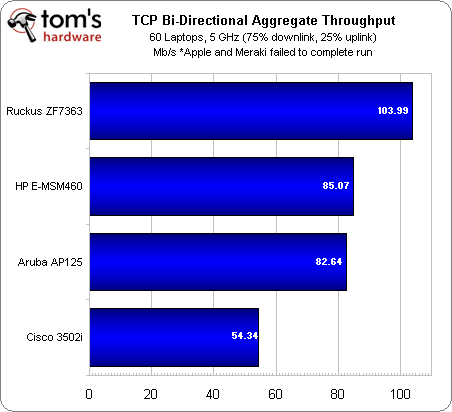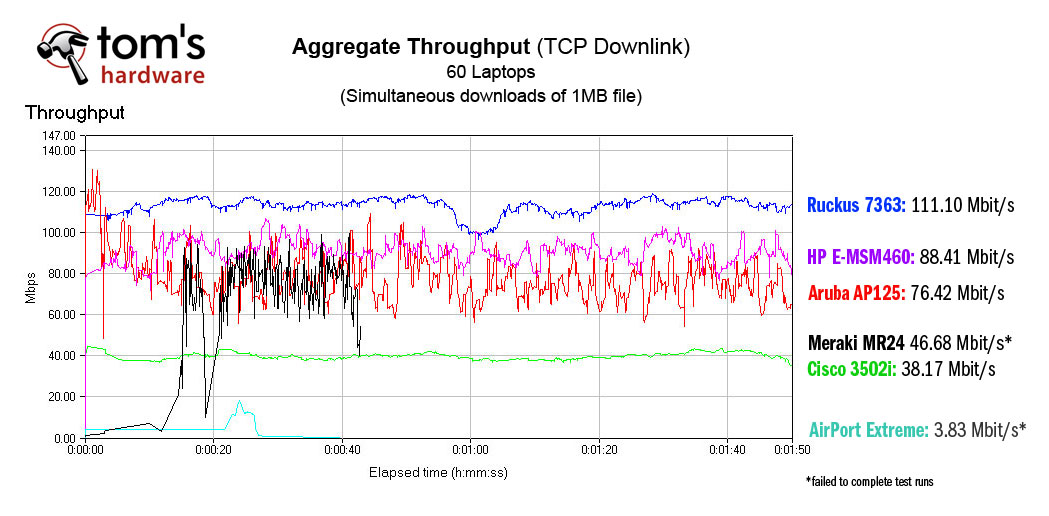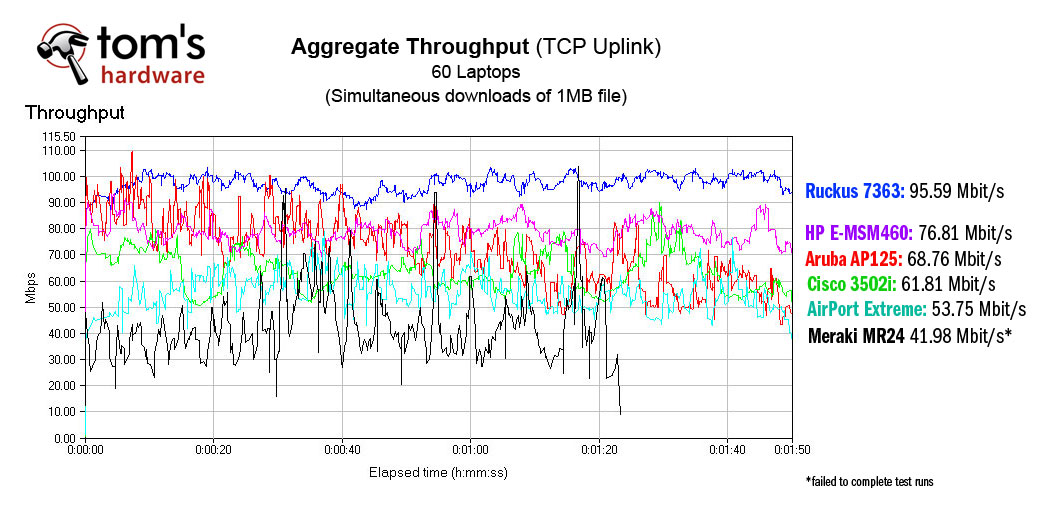Why Your Wi-Fi Sucks And How It Can Be Helped, Part 2
In Part 1, we explained what can go wrong with Wi-Fi signals and how access points can work to improve your wireless performance. It's time for a reality check. We throw six contenders against 65 clients and some hellish interference. Who's left standing?
60 Laptops: Aggregate Performance
In a modern tech enthusiast’s home, it’s not unthinkable that there could be a dozen Wi-Fi devices connecting to a single access point. Just counting laptops and smartphones, how many devices there are connecting at your local coffee shop? Imagine how many there would be in a school gymnasium for a community event or a corporate board room for an all-hands executive meeting. Having 60 notebooks connect to a single AP, all of them running bi-directional traffic concurrently, isn’t far-fetched. How well a given AP performs under such conditions not only determines the quality of the end-user’s experience, but also how many APs an organization has to buy to handle an anticipated load in a given area.
Here we get our first look at how our APs stack up when getting hammered by 60 laptop clients. Trying to reflect a realistic usage scenario, we settled on the ratio of 75% downlink and 25% uplink traffic. Only four APs survived the test.
We know from our first results that optimal throughput for one client is in the 160 to 170 Mb/s range. You’ll get a sense from the iPad data coming up shortly how aggregate throughput increases for multiple, concurrent clients. But there are limits. Any given AP can only handle so much traffic before it starts to strain under the load. Even when we compared aggregate performance of one notebook against ten, Ruckus, Aruba, and HP only showed a 10% to 20% total throughput gain for the notebook group. The aggregate performance for Apple and Meraki actually dropped substantially, already forced to their knees by just ten clients.
Sixty laptops, all transferring 1 MB test files repeatedly, is a pretty heavy burden—too heavy for Apple and Meraki to sustain. Let’s take a closer look at the actual IxChariot data to see what’s really happening.
One of the qualities to look for in an access point or router is the consistency of its connections. When viewed in terms of throughput over time, you don’t want a lot of crazy peaks and troughs. You want users to have a stable connection speed, and the floor of the throughput range is at least equally important. Consider the impact on playback of a 10 Mb/s video stream when 15 Mb/s of average throughput keeps dipping down into the 3 to 5 Mb/s range.
Cisco’s flat download range here looks outstanding. The problem is that it’s so low. Incredibly, both Cisco and Apple fare far better on uplink performance than downlink, no doubt because there’s far less uplink traffic.
Get Tom's Hardware's best news and in-depth reviews, straight to your inbox.
Ruckus offers the flattest, highest results across both data sets, with HP and Aruba both putting in impressive showings. Poor Apple’s chart is almost comical, like it managed a single downlink heartbeat before passing into the great beyond. Meraki at least flopped about in cardiac arrest for a while.
Current page: 60 Laptops: Aggregate Performance
Prev Page Long-Range, 1 Versus 60 Clients Plus Noise Next Page Five iPad 2s: Single And Aggregate Performance-
winner4455 Hey, I still haven't read this article but right away I notice the new format. Just thanking you for listening to your readers! :)Reply -
cangelini Very welcome Winner. We thought the picture story format would work for that last part and didn't realize the text would come out to be so terrible. From now on, we'll only use picture stories when the captions fit without requiring another click!Reply -
tacoslave cangeliniVery welcome Winner. We thought the picture story format would work for that last part and didn't realize the text would come out to be so terrible. From now on, we'll only use picture stories when the captions fit without requiring another click!"Now thats what i like to hear!"Reply -
nekromobo What if you add few thin-foil balls to room (the size of fist or 2)Reply
That should add few rf-reflections or paths, right?
Just your 2cent amplifier.. :) -
I wonder why you didn't include Juniper products (formerly trapeze)to this test. It's quit a big player here in europe. Trapeze also produced the 3com wireless manager and accesspoints which was sold widely here.Reply
-
Hupiscratch In the page "Benchmark Results: Close Range, No Interference", the HP AP is missing on the downlink graph.Reply -
Onus This was an outstanding article. Going just by this, Ruckus and Cisco are the only two I'd consider out of the box, but it would be very interesting to do a follow on that features even a minimal amount of tweaking to see what changes. A consumer expects a product to work well out of the box, but an enterprise network engineer almost certainly does not.Reply
-
Very thorough. Lots of hard work went into this and it shows. But how did you select client devices? Did you try any other chipsets? We tried something like this with more diverse clients and got results that were too variable to reach conclusions. (Some clients just did better with some APs than others.)Reply


